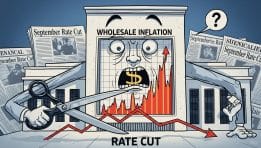Potential U.S. investment in Intel highlights Washington’s push for domestic semiconductor dominance amid global competition and strategic supply chain concerns.
Intel Corp. (NASDAQ: INTC) shares jumped 7% on Thursday after Bloomberg reported that the Trump administration is in discussions to acquire a stake in the company. The move would represent a significant escalation in U.S. government involvement in strategic industries, with the semiconductor sector at the forefront due to its critical role in national security, technological leadership, and economic resilience.
The report indicates that the stake would help fund the construction of Intel’s chip manufacturing facilities in Ohio — a state that has become central to U.S. efforts to reshore advanced manufacturing. If confirmed, this would mark one of the most direct interventions by Washington in the semiconductor market since the enactment of the CHIPS and Science Act in 2022, signaling a new phase in industrial policy under the Trump administration.
Intel’s stock, which had been under pressure for much of the past two years, is now up 19% year-to-date. This rally comes after a disastrous 2024, in which shares lost 60% of their value — the steepest annual decline in the company’s history. The sharp recovery underscores investor optimism that a government partnership could stabilize Intel’s business and accelerate its turnaround.
A Strategic Asset in the Global Chip Race
Intel remains the only U.S. company with the capacity to produce the fastest, most advanced chips entirely on domestic soil. This capability is strategically critical given escalating geopolitical tensions and supply chain vulnerabilities exposed by the COVID-19 pandemic and subsequent trade disputes.
While competitors such as Taiwan Semiconductor Manufacturing Company (TSMC) and Samsung operate facilities in the United States, their most advanced production nodes remain offshore. Washington policymakers view Intel’s domestic manufacturing capability as essential for reducing dependence on foreign suppliers, particularly in sensitive technologies used in defense, artificial intelligence, and critical infrastructure.
President Donald Trump has repeatedly called for more high-tech manufacturing to be brought back to the United States. His administration’s reported willingness to take a direct equity stake in Intel signals that the government is prepared to use financial leverage — not just tax incentives or subsidies — to secure strategic production capabilities.
Lip-Bu Tan’s Leadership Under Political and Market Scrutiny
Intel’s CEO, Lip-Bu Tan, who assumed leadership earlier this year, met with President Trump at the White House on August 11, 2025. The meeting followed public calls from the president for Tan’s resignation over alleged ties to China — allegations that Intel has firmly denied.
In a statement, Intel emphasized Tan’s “deep commitment to advancing U.S. national and economic security interests.” While the company has declined to comment on the specific report of a government stake, it reiterated its alignment with the administration’s goals. “We look forward to continuing our work with the Trump Administration to advance these shared priorities, but we are not going to comment on rumors or speculation,” an Intel spokesperson said.
Tan’s tenure has been defined by two urgent challenges: regaining lost ground in the booming artificial intelligence chip segment, where Nvidia and AMD have taken commanding leads, and successfully building out Intel’s foundry business to manufacture chips for external customers.
Foundry Ambitions and Setbacks
Intel’s foundry expansion is a cornerstone of its turnaround strategy. The company is investing billions in new fabs (fabrication plants) in Ohio, Arizona, and other locations, with the goal of becoming a key manufacturing partner for companies designing cutting-edge chips. However, Intel has yet to secure a marquee customer for its foundry services — a critical milestone needed to build credibility and attract broader industry adoption.
In July, Tan announced that Intel was canceling planned manufacturing sites in Germany and Poland and slowing development in Ohio due to cost concerns and project delays. Spending is now under tighter scrutiny as the company seeks to balance long-term strategic investments with short-term financial stability.
The potential infusion of capital from the U.S. government could change that equation dramatically, enabling Intel to accelerate construction timelines, upgrade equipment, and compete more aggressively for high-profile foundry contracts.
A Broader Pattern of U.S. Government Industrial Intervention
The reported Intel talks are part of a larger trend in which the Trump administration is taking unprecedented steps to directly involve the federal government in critical sectors.
Just last week, the administration announced it would take 15% of certain Nvidia and AMD chip sales to China, a move designed to exert leverage over strategic technology exports. The Pentagon also purchased a $400 million equity stake in MP Materials, a rare-earth mining company, and took a “golden share” in U.S. Steel as part of a deal approving its acquisition by Japan’s Nippon Steel.
This pattern reflects a more interventionist industrial policy, blending national security concerns with economic competitiveness goals. If a stake in Intel is finalized, it could mark one of the most consequential public-private partnerships in U.S. technology history.
Stock Market Reaction and Year-to-Date Performance
Intel’s 7% gain on Thursday lifted its year-to-date performance to 19%, a sharp turnaround from the crushing losses of 2024. Analysts note that investor sentiment toward Intel has been highly volatile, with optimism tied to any news of government support or strategic wins, and pessimism tied to competitive setbacks in AI and foundry operations.
The stock’s rally comes despite lingering structural challenges. Intel has been slower than rivals to adopt cutting-edge manufacturing processes, and its AI chip offerings have lagged behind Nvidia’s H100 and AMD’s MI300 accelerators. Without a strong product lineup in the most lucrative segments of the chip market, Intel’s reliance on government partnerships could grow.
Geopolitical Stakes and the China Question
Any government stake in Intel will inevitably draw attention to U.S.-China technology competition. China remains both a market and a competitor in the semiconductor industry, and U.S. restrictions on advanced chip exports have already strained commercial ties.
President Trump’s call for Tan’s resignation over alleged China links — despite Intel’s rebuttals — reflects the heightened sensitivity of leadership decisions in strategic industries. A government partnership with Intel could be framed as both an economic initiative and a national security safeguard, ensuring that control over key manufacturing assets remains firmly in American hands.
What Comes Next
The Bloomberg report did not specify the size of the potential government stake or the structure of the investment. Key questions remain: Would the stake come with board representation or veto rights? Would it be part of a broader funding package tied to performance milestones? And how would private shareholders respond to government ownership?
For Intel, clarity on these points could be crucial in shaping market reaction. A supportive, non-intrusive government role could be viewed as a catalyst for growth. However, a heavy-handed intervention could raise concerns about corporate autonomy and decision-making flexibility.
Outlook for Intel and the U.S. Semiconductor Industry
If finalized, a government stake in Intel could accelerate U.S. efforts to secure a fully domestic supply chain for advanced semiconductors. This would have ripple effects across the technology ecosystem, influencing supplier contracts, R&D partnerships, and even university research funding in chip-related fields.
In the short term, the news has boosted investor optimism and could provide momentum for Intel’s ongoing turnaround. But the company’s long-term success will depend on its ability to compete technologically with global leaders and win major foundry contracts — goals that cannot be achieved by capital injections alone.
Comparison, examination, and analysis between investment houses
Leave your details, and an expert from our team will get back to you as soon as possible
* This article, in whole or in part, does not contain any promise of investment returns, nor does it constitute professional advice to make investments in any particular field.
To read more about the full disclaimer, click here- Articles
- •
- 5 Min Read
- •
- ago 6 minutes
 US EQUITY FUNDS DRAW WEEKLY INFLOWS ON RATE CUT HOPES
US EQUITY FUNDS DRAW WEEKLY INFLOWS ON RATE CUT HOPES
US equity funds have recently seen significant inflows as investors anticipate possible interest rate cuts by the Federal Reserve. Expectations
- ago 6 minutes
- •
- 5 Min Read
US equity funds have recently seen significant inflows as investors anticipate possible interest rate cuts by the Federal Reserve. Expectations
- Articles
- •
- 7 Min Read
- •
- ago 36 minutes
 Wholesale Inflation Surprise Clouds Fed’s September Rate Cut
Wholesale Inflation Surprise Clouds Fed’s September Rate Cut
Wholesale Inflation Surprise Clouds Fed’s September Rate Cut Plans An unexpected jump in U.S. wholesale inflation is complicating the Federal
- ago 36 minutes
- •
- 7 Min Read
Wholesale Inflation Surprise Clouds Fed’s September Rate Cut Plans An unexpected jump in U.S. wholesale inflation is complicating the Federal
- Articles
- •
- 5 Min Read
- •
- ago 51 minutes
 NINETY ONE’S STOPFORD SAYS US AT EPICENTER OF MARKET RISK
NINETY ONE’S STOPFORD SAYS US AT EPICENTER OF MARKET RISK
Market Risks in the US: Key InsightsNinety One’s Stopford warns that the United States is now the focal point of
- ago 51 minutes
- •
- 5 Min Read
Market Risks in the US: Key InsightsNinety One’s Stopford warns that the United States is now the focal point of
- Articles
- •
- 6 Min Read
- •
- ago 1 hour
 ‘BIG SHORT’ INVESTOR MICHAEL BURRY REVEALS FRESH BETS ON META, ALIBABA, AND UNITEDHEALTH
‘BIG SHORT’ INVESTOR MICHAEL BURRY REVEALS FRESH BETS ON META, ALIBABA, AND UNITEDHEALTH
Michael Burry, best known for his role in “The Big Short,” is making headlines with fresh investments in Meta, Alibaba,
- ago 1 hour
- •
- 6 Min Read
Michael Burry, best known for his role in “The Big Short,” is making headlines with fresh investments in Meta, Alibaba,












